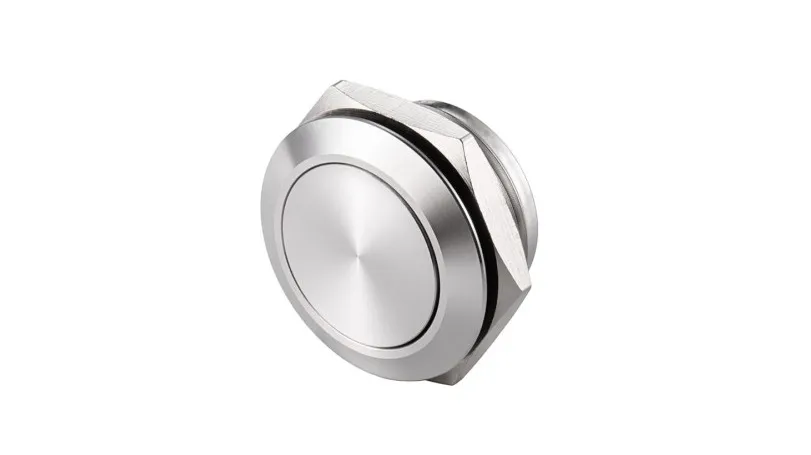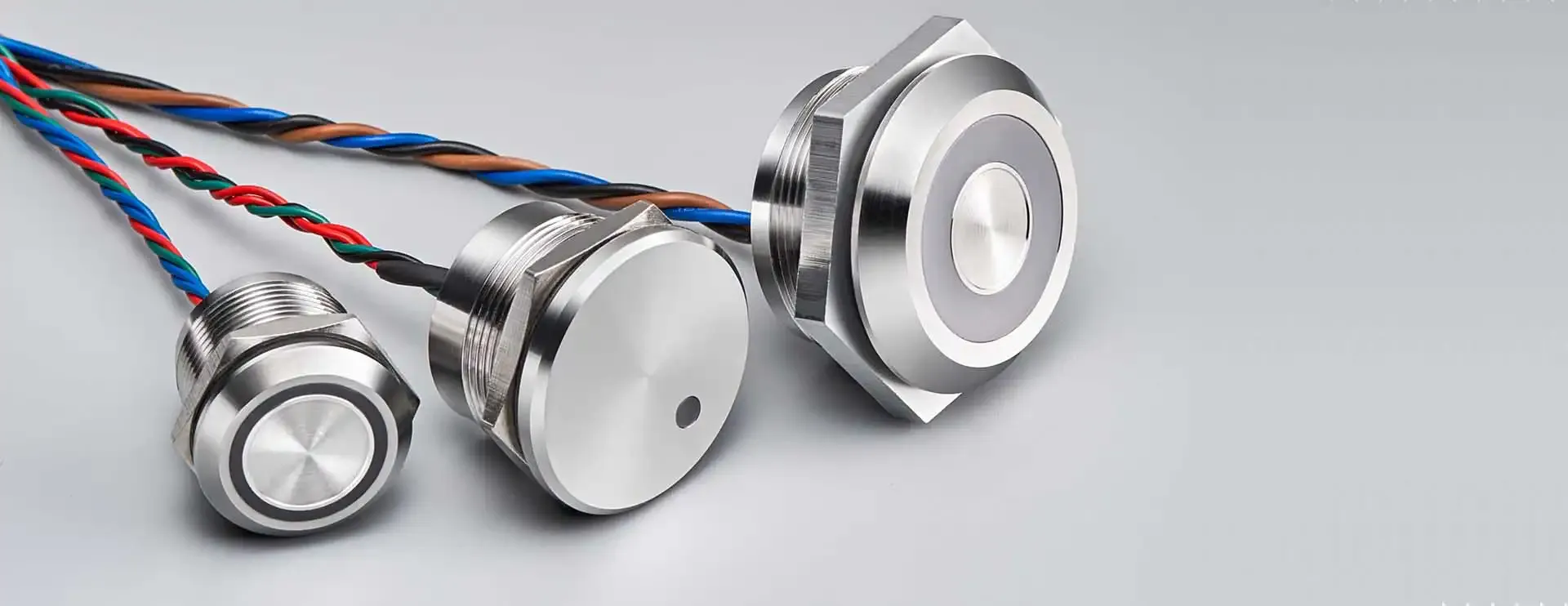Ever wonder if a low profile push button switch travels shorter than a regular one? This post breaks down travel distance in push button switches and digs into what makes a low profile switch different. It gives clear comparisons between low profile and normal switches. You’ll learn why this matters for fast, bulk orders and how it can solve problems during production.
Travel Distance in Push Button Switches
This section breaks down total travel measurement, explaining what pre-travel or actuation distance means. It shows how travel distance affects the switch feel, and compares standard travel distances in conventional switches. The document covers how these factors tie into power supply management, electric current flow, and even a light curtain setup.

Contact Langir for Custom Low Profile Push Button Switches
Understanding Total Travel Measurement
The total travel measurement shows how far low profile push button switches move before they register a press. It helps customers know if a switch is crisp like a well-set screw or reliable like a contact Langir design, with a touch of silver quality even on a mac setup.
Grasping this means the pre-press and full press differences directly affect current flow and power setups, giving customers more control over their device configuration:
What Pre-Travel or Actuation Distance Means
Pre-travel distance sets the stage for the push button switch feel. It defines the moment when a press begins before making full contact, which can change the overall device experience and affect how components like the printed circuit board share the workload between parts, such as logitech mechanisms and glass finishes:
How Travel Distance Affects Switch Feel
Switch feel stops at measurement — how far the button travels affects if the output is crisp and responsive or if it drags. This measurement plays a key role in a keypad setup, where a short travel with a screw terminal connection may allow a proximity sensor to enable faster reactions; consider these factors:
- Pre-travel measurement for immediate response
- Full travel measurement for consistent performance
- Screw terminal efficiency supporting faster sensor enablement
Standard Travel Distances in Conventional Switches
The standard travel distances in conventional switches sit at a set measurement that offers a solid, predictable feel when pressing a button, and experts note that low profile switches may indeed travel a bit shorter. Key factors include consistent travel mechanics, reliable actuation force, and precise diameter adjustments that make for a smooth tool usage experience with every keycap press:
- Button response consistency
- Tool efficiency with each stroke
- Keycap design compatibility
- Engineered actuation force
- Controlled diameter for robust performance
Characteristics of a Low Profile Push Button Switch
Low profile push button switches boast reduced height and a slim design, thanks to key components that cut down force and speed up motion. Their build, using quality materials and refined construction, ensures reliable electricity relay in compact settings. Customers can see practical applications in everyday devices while enjoying a balance of speed and dependable performance.

Contact Langir for Custom Low Profile Push Button Switches
Reduced Height and Slim Design Features
The low profile push button switch stands out with a slim design and reduced height, making it adept at curbing pressure fluctuations even when a finger hits it at high speed. This design not only deters vandals with its subtle form but also improves the electrical contact between components, ensuring that every light tap delivers a steady response.
Key Components Contributing to Lower Profile
Engineers detail how a well-designed alloy frame, strategic anode placement, and carefully set actuation angle work together to reduce fatigue and risk, crafting a lower profile that stays agile even with constant use:
Common Applications for Low Profile Switches
Low profile switches often find their place in devices where space is tight yet performance must be smooth, like on laser-guided machines or in setups where a compact table of contents in design manuals makes a difference. Engineers depend on these switches to handle precise voltage and maintain a steady volt output, making them perfect for gadgets that need quick, reliable responses without any fuss.
Materials Used in Low Profile Switch Construction
Low profile switch construction relies on high-quality metals and durable plastics that give it the perfect form factor while leaving extra space for other vital components, much like a reliable circuit breaker that keeps everything in line. Engineers use materials reminiscent of sturdy alps-grade alloys to cope with daily wear and tear, ensuring the switch is both compact and robust—ideal for setups that demand reliability even on a heavy-duty cart. The careful selection of these materials means users get a steady, dependable switch without compromising the overall design efficiency.
Comparing Travel Distance Low Profile vs Normal Switches
Low profile push button switches feature a shorter travel than standard models, with actuator design tweaks delivering a more tactile feel. They move a bit less—a small bit that makes all the difference in vehicle control panels and color-coded setups. The following sections break down typical ranges, measurement details, and factors trimming the travel in these clever designs.

Contact Langir for Custom Low Profile Push Button Switches
Typical Travel Ranges for Low Profile Switches
Low profile push button switches tend to have a shorter travel range, which keeps the electronics crisp and responsive even when the operating temperature varies; engineers craft these switches with robust steel parts and a reliable dome design to ensure a computer-grade performance every time.
Typical Travel Ranges for Standard Push Button Switches
The standard push button switch usually offers a firm and consistent travel range that even a consumer can trust, with a reliable pin mechanism and robust plastic construction to maintain steady performance—unlike its low profile push button switch cousin, which favors a shorter, snappier feel, almost like an optical fiber keeping things neat.
Direct Measurement Low Profile Push Button Switches Travel Shorter
Direct measurements confirm low profile push button switches move noticeably shorter, thanks to their refined actuation mechanisms and sturdy stainless steel construction. This shorter travel not only improves precision in automation systems but also minimizes error risks in setups where even a loose wire or a missing nut could throw off performance; experts recommend joining a mailing list for updates and tips on optimizing your switch configuration.
Factors Influencing the Shorter Travel in Low Profile Designs
Engineers note that the shorter travel in low profile designs ties back to the precise shape of the internal components and the type of metal used, which results in a switch that feels different from normal ones. The brand’s commitment to quality includes careful soldering techniques that prevent dust build-up and ensure durability, giving customers a switch that responds quickly with every press.
Visualizing the Difference in Switch Height and Travel
The visual difference in switch height and travel is as clear as a boat moving through calm water—a low profile push button switch truly travels shorter, giving a tighter feel that minimizes heat buildup and improves capacitor life. Engineers see this clever design tweak as a way to boost feedback and overall response, much like a well-tuned membrane switch keeping everything on track in any setup.
Do Low Profile Push Button Switches Travel Shorter | FAQs
What determines travel distance in push button switches?
Push button switch travel distance is set by the internal design and spring mechanism. Precision manufacturing and material choices determine how far the button moves, ensuring consistent performance, tactile feedback, and durability.
Do low profile buttons travel less distance?
Yes, low profile buttons generally travel a shorter distance. This ensures a compact design with a quick snap response—ideal for efficient, reliable operation in industrial applications.
How is travel distance measured in switches?
Travel distance in switches measures the button’s movement before it activates. It’s usually expressed in millimeters or inches, helping designers ensure a smooth, consistent feel for each push button application.
What makes low profile switches unique?
Low profile switches pack big performance in a slim design. They provide fast, reliable action perfect for tailored industrial projects—ideal for bulk push button switch solutions without taking up extra space.
How do normal switches compare to low profile ones?
Standard push button switches are bulkier while low profile ones save space. Both deliver solid performance, but low profile versions offer a sleek design that works well in compact, industrial setups.
 EN
EN
